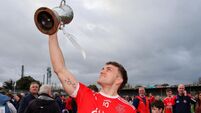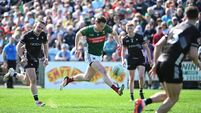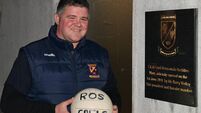John Fogarty: NFL visit a reminder of how different the GAA is

Pittsburgh Steelers’s linebacker TJ Watt’s new three-year contract is worth €105 million. When Steelers and Vikings players lineout at Croke Park on Sunday, the notion that those who usually play at the stadium do so for free will be alien to the NFL stars. Pic: Joe Sargent/Getty Images
As sure as night follows day, no sooner will the NFL have ensconced themselves in Croke Park this week that a demonstration of the native games will be put on and one of the American entourage will baulk, “These guys do it for free?” In a sport where dollar signs are worn almost as regularly as they are thought about, there will be little understanding for the sensibilities of the GAA. The Pittsburgh Steelers’s linebacker TJ Watt’s new three-year contract is worth €105 million. Inter-county footballers and hurlers are more likely to be considered chumps than champions for not getting their greenbacks.
The arrival of the Steelers and Minnesota Vikings comes at a crucial time for the Gaelic Players Association (GPA). Last week, they submitted their pre-budget proposal for government grants to be increased by almost €1,000 to €2,500 per inter-county player in the male and female codes.
Read More
It's not an unreasonable request bearing in mind the figure was once over €1,900, rising inflation and the €10m the Government have provided for the hosting of Sunday’s NFL Week 4 game in Croke Park.
The problem for the GPA is the context. They are making this demand just as energy credits are being discontinued and next month’s Budget is expected to take a more targeted approach.
Aside from those pursuits, the GPA’s funding negotiations with the GAA have not being going well. That isn’t unusual: previous talks have broken down yet it’s nearly 12 months since the GPA and GAA first sat down to hammer out a new deal.
Oversight, image rights and bursaries are believed to be among the outstanding issues. Croke Park wants to have more of a say in how the GPA spends its money. There is good reason for that when as this newspaper reported last year that the players’ body in 2022 gave €30,000 to a former player under Garda investigation.
On the other hand, the GPA have made a case for more control of image rights. Shane O’Donnell’s argument about his likeness being used to sell GAAGO without his permission was a convincing one. While bursaries are another thorny issue as the GPA claim student inter-county players can’t work part-time because of their football or hurling commitments.
In our colleague Mike Moynihan’s excellent new book , GPA chief executive Tom Parsons speaks of how difficult it is for such a player. “There’s not a hope in hell he can hold down a bar job on a Saturday night for pocket money.”
Parsons also describes the double life inter-county players are being asked to lead in the GAA. “What the GPA is grappling with as a player representative body is that these players are in both worlds. For half the year, they’re involved in voluntarism, the local club, being local volunteers and coaching sessions themselves, being the face of the club for fundraising – voluntarism to the core.
“For the other half of the year, you’re still an amateur and a volunteer but you’re also asking, ‘Hold on, is everybody a volunteer here the way everyone in my club is a volunteer?’ And that may not be the case at inter-county level.
“At the club level, a coach may be someone’s dad, but at inter-county the coach is more likely to be a seasoned campaigner who’s well compensated. Food after training at inter-county isn’t ham sandwiches being pulled together by the parents in the club but a catering company – professionals again.
“The players are looking at that. And they’re saying, ‘Of course, we want to be amateurs’ but they’re also asking why, in this two-tier system, so many people are professionals but players are amateurs and at a cost? To be an amateur anything, there’s a cost.”
Parsons’s comments are interesting for a variety of reasons. Their own survey last year stated 92% of players were in favour of managers being paid formally. Their overwhelming support doesn’t suggest they are dissatisfied by those around them already being remunerated yet their own backing for the GAA’s amateur status fell from 71% to 59% in the space of a year.
It is the contention of the GPA that an inter-county player is out of pocket €4,600 a year but how many have benefitted, be it in access to gyms, general well-being or catering, from their involvement with a county set-up? What have they actually saved having access to such resources?
Undoubtedly, other ways of providing more for inter-county players should be explored. As the GAA engages with the revenue commissioners about the voluntary disclosures counties have to make, part of their discussions should include how they can make the lives of the leading footballers and hurlers easier. It can be about keeping rather than putting more money in their pockets.
It isn’t schmaltzy to suggest the NFL’s visit this week serves a reminder of how the GAA is unique. Neither is it that mawkish to say it is paramount it be protected.
john.fogarty@examiner.ie
Little or no GAA silverware is won in September these days. Nevertheless, it’s a pivotal month and this past weekend a lot of pride was lost.
Portumna, winners of four All-Ireland championships in eight years, said goodbye to senior hurling in Galway following 33 years.
In Dublin, by far and away its most decorated and venerable football club St Vincent’s were demoted to senior 2 football in 2026 having previously gone down in 2021 before coming straight back up the following season.
Meanwhile, their equivalent in Meath, Navan O’Mahonys, are on the cusp of dropping to junior after losing an intermediate relegation semi-final just three years after they were knocked out of the senior championship for the first time in their history. Lose to Curraha later this week and O’Mahonys will suffer a plunge of staggering proportions.
For the likes of Portumna, demographics have contributed to the club’s difficulty and this latest setback comes five years after they were demoted to senior B. Whereas for O’Mahonys, their tale of woe is one of distractions and more focus put on other growing areas of the county.
If the last five days have underlined one truism of club GAA, it’s that no outfit is too big to go down. Austin Stacks were living proof of that in 2022. No club is too big to stay rooted to intermediate either: Laune Rangers, who have languished there the last 10 years, are that case in point.
Peter Queally said the quiet bit out loud upon Waterford departing the championship in May for the third year in a row. “We've been training since October. Don't say that too loudly because we’re not meant to be.
“We've been training in all the winter months. It’s now the ground is hard. We want to be hurling and we're gone out of the championship. Clare are gone out of the championship and every other team is nearly still in the championship.”
As Queally, Brian Lohan, Keith Rossiter and Johnny Kelly await to hear when they can get the band back together for the new season, it’s natural they will want to get a head start.
Both Waterford and Clare’s championships concluded eight weeks before All-Ireland finalists Cork and Tipperary. To suggest they should all come back at the same time makes little sense. Similarly, if the Munster Senior Hurling League returns in January, why should Stephen Bennett or Tony Kelly be precluded from playing it when their hurling is done for the year? It shouldn’t just be a competition for developing players.
The one-size-fits-all approach to the closed season has proven not to work – the Gaelic Players Association (GPA) themselves admitted counties trained last year when they weren’t permitted.
At least Queally was honest but to expect him to sit on his hands until November when it will be six months since Waterford last played a game is unfair. Although it too was abused, the GAA once operated a phased return to training. With genuine supervision, it should be reintroduced.



